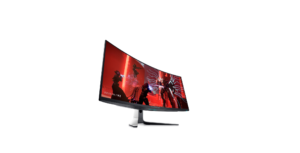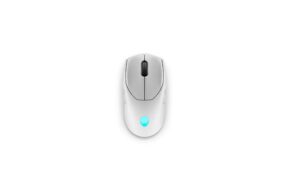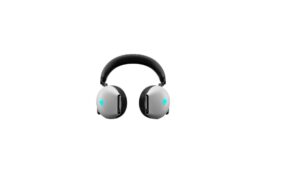DELL AC511M Stereo Sound Bar with bracket User Manual

What’s in the box
NOTE:
The documents that are shipped with the sound bar may vary based on your region.

- Bracket
- Thick rubber cushion
- Documents
- Soundbar
Features

- USB cable
- Aux-in port
- Headphone port
- Left T-Hook
- Right T-Hook
- Power LED
- Volume knob
- Bracket
- Thick rubber cushion
Setting up your sound bar
Installing the sound bar to your Dell monitor
Without bracket
- Align the tabs on the sound bar to the slots on the monitor base.
- Slide the sound bar to the right to secure the soundbar onto the monitor base

With bracket

- Pull the bracket’s clamp.
NOTE: Use the thick rubber cushion between the bracket and the non-swivel base monitor stand. - Secure the bracket to the monitor stand.

- Push the bracket down to align it with the stand base.
- Align the tabs on the sound bar with the slots on the bracket. Slide the sound bar to the right to secure the soundbar to the bracket.

Turning on your sound bar
NOTE:
If the sound bar is not detected, connect the uplink cable that came with your Dell monitor. Connect one end of the uplink cable to the USB port on the Dell monitor and the other end to the USB port on your Dell computer.
Connect the USB cable of the sound bar to the USB port of the Dell monitor.

Connecting your sound bar
Use the audio-in or aux-in jack to connect your audio device such as a tablet or smartphone to your Dell sound bar.
Audio-in port
You can play audio using the audio-in cable that comes with your sound bar.
- Connect the audio-in cable to the aux-in port on the left side of the sound bar.
- Connect the other end of the audio-in cable to your audio device.
- Play music and adjust the volume as desired.
NOTE: When audio in is the default playback device, the light on the microphone button turns solid red. The sound bar microphone cannot be used in this playback mode.

Headphone jack
- Connect the headphone to the headphone jack on the sound bar.
- Play music and adjust the volume as desired.
- Press the Default playback button on the left side of the sound bar to toggle between the speaker and headphone.
NOTE: The Default playback button is disabled when the headphone is not connected to the sound bar.

Adjusting the volume
You can directly control the volume of a computer using the volume knob on the sound bar.

Troubleshooting
| Possible solutions | Problems | Possible causes |
| · If required for your Dell monitor, connect one end of the uplink cable to the USB port on the Dell monitor and to the USB port on your Dell computer. · Once the USB cable is plugged into the USB power source, observe if the white LED on the right of the sound bar lights up. · If the LED is not lit, check if the USB is properly inserted to the USB port. · If LED is lit and the sound bar does not function, remove or unplug the sound bar from the system and restart the computer. · Plug in the sound bar again and check if the LED lights up. · If the sound bar still fails to connect, check if the sound bar is present in Device Manager. · Swap the USB sound bar to another USB port. · If the other USB port works, the first USB port maybe faulty. · If the other USB port does not work, follow the steps below. · Swap with a known-good USB Speaker or device (e.g. keyboard) or connect the sound bar to another system. · If there is no other mouse or system available to test with, | Sound bar not functioning properly. | Sound bar not detected or synchronized. |
| use a known good USB keyboard (or any other USB device) to see if it works on the same USB port. · If the known good USB device is not working on the same port, or the original sound bar works properly on another system, the former system’s USB I/O may be defective. · If known good USB device works, or the sound bar does not work properly on another system, replace the sound bar with a good one. | ||
| No Sound | Sound bar has power – power LED indicator is on. | · If playing through USB streaming, ensure that a music file is playing from the platform and the volume level is not 0%. · If playing through external music devices such as MP3 player, iPod/iPad/iPhone or any other Android phone, ensure that the aux-in cable is properly connected. · Ensure that the external music device volume is not 0%. · If playing through USB streaming, set all Windows volume controls to their maximum. · Play some audio content on the computer (for example, an audio CD or MP3 player). · Turn the volume to a higher level by rotating the sound bar volume knob clockwise. · Clean or re-seat all cables again. · Test the sound bar with a |
| different music source (for example, a portable CD player or an MP3 player). · Go to the control panel of the computer and click on Sound. · Try different ports. · Re-install the on-board drivers or the sound card drivers. Restart the computer. · Try with a speaker that is known to be good. | ||
| No sound | No sound from USB audio source. | · Check if a 3.5 mm aux-in cable is inserted in the sound bar aux-in jack. · Remove the 3.5 mm aux-in cable from the aux-in jack. |
| Distorted Sound | Computer’s sound card is used as the audio source. | · Clear any obstructions between the sound bar and the user. · Confirm that the audio line-in plug is completely inserted into the jack of the sound card. · Set all volume controls to their midpoints. · Decrease the volume of the audio application. · Turn the volume level to lower setting by rotating the sound bar knob counter-clockwise. · Clean and re-seat all cables again. · Troubleshoot the computer’s sound card. · Test the sound bar using another audio source (for example, a portable CD player or an MP3 player). |
| · Ensure no loose objects are touching the sound bar. | ||
| Distorted Sound | Other audio source is used. | · Clear any obstructions between the sound bar and the user. · Confirm that the USB cable or audio line-in plug is completely inserted into the jack of the audio source. · Decrease the volume of the audio source. · Turn the volume level to a lower setting by rotating the sound bar knob counter- clockwise. · Clean and re-seat the cables again. · Turn off the sound processing of the audio source. · Ensure that the sound bar is attached on the monitor. · Ensure no loose objects are touching the sound bar. |
| Unbalanced sound output | Sound is coming from only one side of the sound bar | · Clear any obstructions between the sound bar and the user. · Confirm that the audio line-in plug is completely inserted into the jack of the sound bar or audio source. · Set all Windows audio balance controls (L-R) to their midpoints. · Clean and re-seat all cables again. · Troubleshoot the computer’s sound card. · Test the sound bar using another audio source (for |
| example, a portable CD player or an MP3 player). | ||
| Low volume | Volume is too low. | · Clear any obstructions between the sound bar and the user. · Turn the volume to a higher level by rotating the knob clockwise. · Set all Windows volume controls to their maximum. · Increase the volume of the audio application. · Test the sound bar using another audio source (for example, a portable CD player or an MP3 player). |
| Buzzing noise | Noise from the sound bar | · Is the sound bar properly attached to the Monitor and no obstruction? · Ensure that the sound bar is attached to the monitor and no loose objects are hanging or touching the sound bar. · Try reducing the volume to a low level by rotating the knob counterclockwise. · Ensure the wires do not interfere with the sound bar. |
| Aux-in no sound | No sound using the aux-in function. | · Is the aux-in cable plugged in? · Ensure that the aux-in cable is properly plugged in the sound bar’s aux-in jack and on the aux-out jack of the audio device. · Try using a different or known good aux-in cable. |
| · Is the external audio device turned on or is playing music? · Check if the audio device is turned on or is playing music. · Ensure that the audio device volume is not set to 0% volume level. · Try replacing the audio device with a known good audio device. | ||
| Aux-in distortion | Is the aux-in cable properly plugged in? | · Clear any obstructions between the sound bar and the user. · Confirm that the audio line-in plug is completely inserted into the jack of the audio source. · Decrease the volume of the audio source. · Turn the volume level to a lower setting by rotating the sound bar knob counter- clockwise. · Clean and re-seat cables again. · Turn the bass or wave setting lower. · Turn the “Wow Surround” setting lower. · Ensure the sound bar is properly attached on the monitor. · Ensure no loose objects are touching the sound bar. |
| Headphone jack connected, but no sound is heard. | USB streaming or external audio source is not playing music and volume is 0%. | · Check if the platform music player or external audio source is playing music. · Check if the audio source and the sound bar volume are not set to 0%. |
| Headphone jack connected. | Audio distortion. | · Check if the headphone plug is properly inserted into the sound bar headphone jack. · Check if the headphone plug is not showing intermittent connection. · Check if the music file is not distorted when playing without the headphone or connected to a known good headphone. |
| Cable not long enough and extension cable cannot connect to speaker USB cable. | USB extension cable | · Check if the 300 mm sound bar cable length is not enough to connect the sound bar to the USB port, use the USB extension cable to connect the sound bar to the USB port. · Check if the USB cable is not damaged. |
| Sound bar cannot mount onto monitor. | T-Hook | · Check if the T-Hook is missing. · Check if the T-Hook is not damaged or broken. · Check if the Monitor/LCD sound bar slot is open and that no Mylar covers obstruct the slots. |
| Missing items | Packaging check | · Open the box and check if the USB extension is present inside the package. · Check if all items as show in “Contents of the box” are present inside the package. |
Specifications
| General | |
| Model number | AC511/AC511M |
| Connection type | USB |
| Supported operating systems | · Microsoft Windows 8 |
| · Microsoft Windows 7 | |
| · Microsoft Windows 10 | |
| Electrical | |
| Operating voltage | 5 V |
| Audio input | USB Digital Audio input |
| Analog Audio Aux-in (3.5 mm jack) | |
| Output power | 2 x 1.25 W at ≤10% THD |
| Physical Characteristics | |
| Sound bar dimensions: | |
| Width | 406.00 mm (15.98 in) |
| Height | 39.00 mm (1.54 in) (including T-Hook) |
| Depth | 49.00 mm (1.93 in) |
| Weight | 454 g (1.0 lb) |
| Bracket dimensions: | |
| Width | 230.11 mm (9.06 in) |
| Height | 56.08 mm (2.21 in) |
| Depth | 63.57 mm (2.50 in) |
| Weight | 74 g (0.16 lb) |
Statutory information
Warranty
Limited warranty and return policies
Dell-branded products carry a 1-year limited hardware warranty.
For U.S. customers:
This purchase and your use of this product are subject to Dell’s end-user agreement, which you can find at www.dell.com/terms. This document contains a binding arbitration clause.
For European, Middle Eastern, and African customers:
Dell-branded products that are sold and used are subject to applicable national consumer legal rights, the terms of any retailer sale agreement that you have entered into (which will apply between you and the retailer) and Dell’s end user contract terms. Dell may also provide an additional hardware warranty—full details of the Dell end user contract and warranty terms can be found by going to www.dell.com, selecting your country from the list at the bottom of the “home” page and then clicking the “terms and conditions” link for the end user terms or the “support” link for the warranty terms
For non-U.S. customers:
Dell-branded products that are sold and used are subject to applicable national consumer legal rights, the terms of any retailer sale agreement that you have entered into (which will apply between you and the retailer) and Dell’s warranty terms. Dell may also provide an additional hardware warranty —full details of Dell’s warranty terms can be found by going to www.dell.com, selecting your country from the list at the bottom of the “home” page, and then clicking the “terms and conditions” link or the “support” link for the warranty terms.






